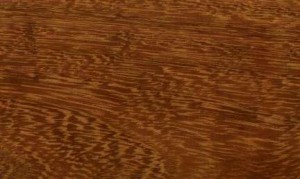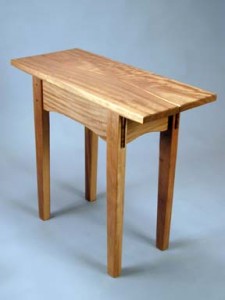Iroko, as seen in the Wood Explorer database.
Trade Names: Iroko, African teak.
Kingdom: Plantae – Plants
Subkingdom: Tracheobionta – Vascular plants
Superdivision: Spermatophyta – Seed plants
Division: Magnoliophyta – Flowering plants
Class: Magnoliopsida – Dicotyledons
Subclass: Hamamelididae
Order: Urticales
Family: Moraceae – Mulberry family
Genus: Chlorophora Gaudich. – african teak
Species: Chlorophora excelsa (Welw.) Benth. – african teak
Janka Hardness (pounds-force): 1260
Greg Kriebel’s example of an Iroko Sideboard seen here.
Description: Iroko has heartwood of a light brown color which usually deepens in hue over time. Iroko is relatively coarse with interlocking grain and open pores. The Wikipedia explanation of Iroko includes a summary that the tree is considered sacred to the Yoruba people of Benin and Nigeria. The belief stated there is that anyone who sees the Iroko man face to face dies from insanity. I try to keep the Iroko out of my home for this reason alone. Yoruba legend extends great misfortune to the woodcutter of the iroko tree, but it is unclear whether this extension applies to the woodworker yielding finished product, so I’ll make a broad assumption that the guy felling the tree and his family are the only misfortunates affected by the Yoruba curse.
Mr. Ibu & Tonto Dikeh have a shared excitement of all things Iroko.
Location: Africa, namely: Angola, Gambia, Guinea, Liberia, Sierra Leone, Senegal, Ivory Coast, Ghana, Congo.
Common Aliases: Abang, Cambala, Kambala, Mandji, Mokongo, Moreira, Mvuli, Odoum, Odum, Oroko, Semli, Rokko, Timmi, Tule mufala
Performance: Interlocking grain pattern can cause some challenges in performance, but all in all, Iroko is easy to work. Iroko is oftentimes used as a substitute for Teak, much more so in Europe, Africa, and the East than in the United States.
Affordability: $$ The key issue here is availability. When available in the United States market, it is an affordable and very durable tropical hardwood alternative.
Common Uses: Boat construction, Cabinetry, Carvings, furnishings, flooring, interior construction, millwork, hatracks, piling, audio equipment, veneer, plywood, wheels.
From: The Wood Database:
Common Name(s): Iroko
Scientific Name: Milicia excelsa, M. regia (syn. Chlorophora excelsa, C. regia)
Distribution: Tropical Africa
Tree Size: 100-130 ft (30-40 m) tall, 3-5 ft (1-1.5 m) trunk diameter
Average Dried Weight: 42 lbs/ft3 (675 kg/m3)
Basic Specific Gravity: .55
Hardness: 1,260 lbf (5,610 N)
Rupture Strength: 12,700 lbf/in2 (87,590 kPa)
Elastic Strength: 1,360,000 lbf/in2 (9,380 MPa)
Crushing Strength: 7,840 lbf/in2 (54.0 MPa)
Shrinkage: Radial: 2.8%, Tangential: 3.8%, Volumetric: 8.8%, T/R Ratio: 1.4


